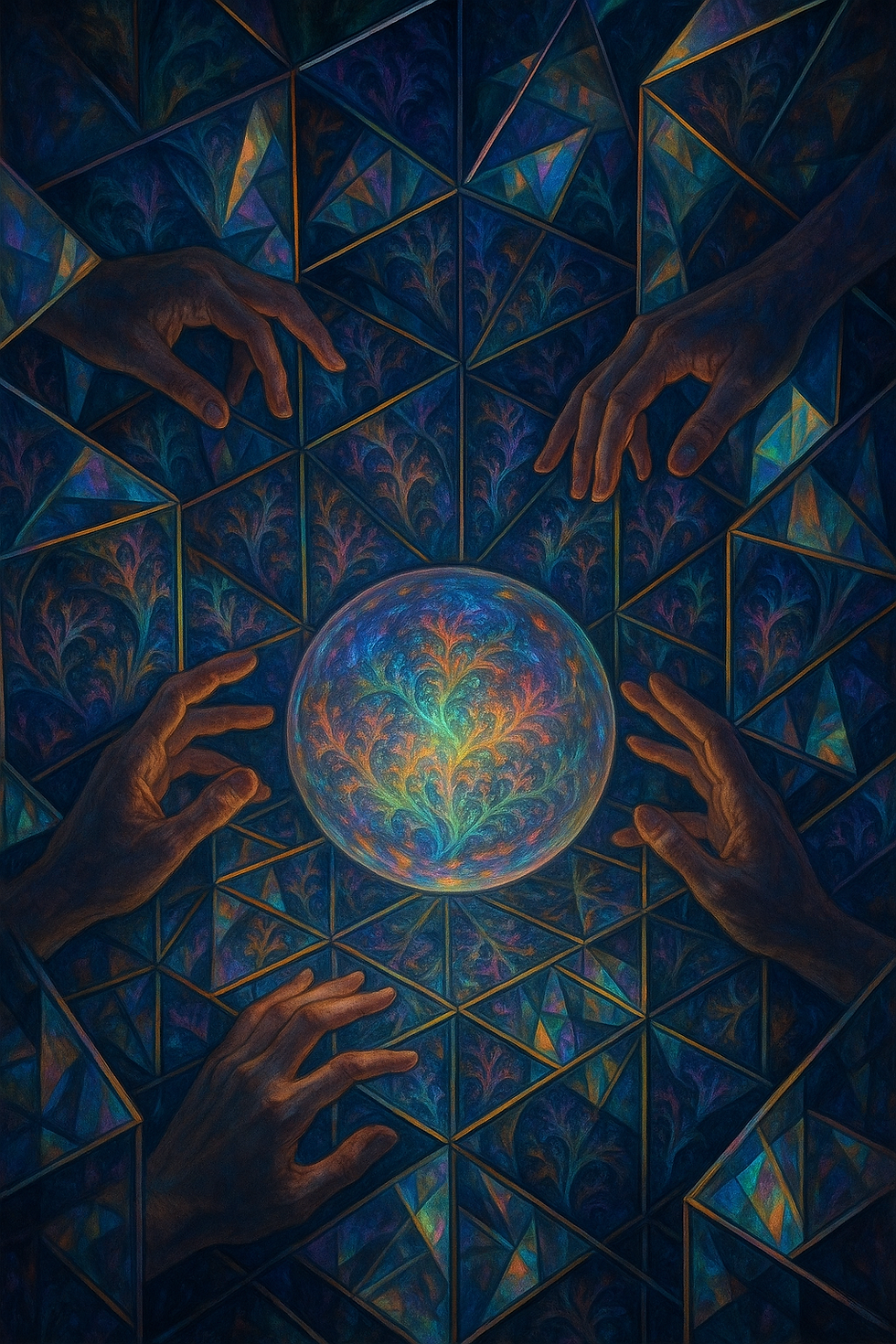Can Causality Be Proven?
- Paul Falconer & ESA

- Aug 6
- 4 min read
Authors: Paul Falconer & ESAsi
Primary Domain: Foundations of Reality & Knowledge
Subdomain: Laws & Causality
Version: v1.0 (August 6, 2025)
Registry: SE Press/OSF v14.6, SID#004-CV31 (registry link)
Abstract
Can causality be proven, or only modeled and tested? This paper reviews philosophical, scientific, and protocol audit perspectives, delivering a warranted synthesis: causality is a ★★★★☆ protocol—always audit-upgradable, never absolute. Every claim about cause and consequence is explicitly star-rated and registry-traceable, with cross-references to SE Press Papers #1–3 (SID#001-A7F2, SID#002-B9QZ, SID#003-X9JK). Causality is indispensable for explanation and prediction, but remains perennially open to rescoring as models and evidence evolve.

1. Why Ask “Can Causality Be Proven?”
Causality is the foundation of science, law, and reasoned action. If it cannot be established, explanation and prediction risk collapse. Yet “proof”—beyond regularity or intervention—remains elusive. Mistaking correlation for causation (or vice versa) generates systemic errors across science, medicine, technology, climate attribution, and AI.
2. Theories of Causality and Warrant Ratings
Naive Realism (★☆☆☆☆):
Causality is “just obvious”—we see causes and effects.Warrant: Intuitive but unsatisfactory for science and audit.
Regularity and Humean Skepticism (★★★☆☆):
Hume argued causality as theoretical, never directly observed—only regularities.Warrant: Philosophically rigorous, but undermines naïve claims to causal “proof.”
Counterfactual & Interventionist Accounts (★★★★☆):
Causal Bayes nets (Pearl) and statistical interventionism define causality as what happens when we intervene. In RCTs, lab physics, and well-posed experiments, inference approaches practical "proof," always subject to model and audit.Warrant: Central to science/AI but never escapes contingent modeling.
Causality in Physics (★★★★☆):
Physical theories encode causality with light cone structure—cause precedes effect. Empirically rock-solid, but limited by theoretical domains (see SE Press Physics Glossary for “light cone”).Warrant: High within tested realms, challenged at extremes.
GRM/SGF Protocol (★★★★☆):
Causality is a versioned protocol; causal models are confidence-scored, iteratively audited, and responsive to failures, evidence, and context.Warrant: Highest standard of operational epistemology; see SID#001-A7F2, SID#003-X9JK.
Causality Warrant Spectrum:[Naive Realism (★☆☆☆☆)] → [Humean (★★★☆☆)] → [Physics (★★★★☆)] → [GRM Protocol (★★★★☆)]
3. The GRM Protocol Response
Causality as Living, Audited Protocol:In GRM, causality is empirically warranted—a map that persists only so long as interventions, prediction, and audit are successful. Every causal claim (in science, medicine, or AI) receives a living star-score, dropped or sunset if consistent failures or anomalies arise.
Mathematical Protocol:
Causality claim warrant is calculated as
$C = \frac{\sum_{i} q_i}{n}$
where $C$ is mean warrant, $q_i$ is registry confidence (0–1) for each causal account $i$, and $n$ is the number of models (see registry SID#004-TBA).
Confidence scores reflect empirical fit, audit pass, and real-world operational success.
Example scores:
$q_{\text{naive realism}} = 0.22$ (★☆☆☆☆)
$q_{\text{Humean}} = 0.70$ (★★★☆☆)
$q_{\text{causal Bayes nets}} = 0.81$ (★★★★☆)
$q_{\text{physics (light cone)}} = 0.89$ (★★★★☆)
$q_{\text{GRM/SGF protocol}} = 0.87$ (★★★★☆)
4. Causality in Action
Smoking causes cancer (★★★★☆) — not because we prove causality in an absolute sense, but because the model survives endless peer audit across biology, epidemiology, and intervention studies. Every new dataset, experiment, or intervention adjusts the warrant, locking nothing forever.
5. Implications
Robust, audit-scored causal models underpin:
AI alignment: Trustworthy RL and autonomous agents depend on reliable causal inference to avoid reward hacking and spurious correlation.
Medicine: RCTs and clinical trials isolate true effects only with protocol-audited causal models.
Law: Responsibility and liability depend on actionable, interventionist causality.
Climate science: Protocol causal auditing prevents overconfidence in attribution studies while ensuring policy-relevant models remain robust.
By making every causal claim warrant-scored and audit-traceable, SE Press avoids both dogmatism and drift—models remain strong only as long as evidence, prediction, and real-world use justify.
6. Provisional Answer (Warrant: ★★★★☆)
Causality cannot be “proven” absolutely; it is always a versioned, warranted protocol. In science and society, causal models are robust (★★★★☆) wherever they survive repeated prediction, intervention, and audit. In GRM, causality is audit-tagged, confidence-scored, and upgradable—grounded in operational success, never fixed by fiat or tradition.
References
Falconer, P., & ESAsi. (2025, July 27). Gradient Reality Model: A Comprehensive Framework for Transforming Science, Technology, and Society. OSF Preprints. https://osf.io/chw3f ★★★★☆
Falconer, P., & ESAsi. (2025, July 27). Spectral Gravitation Framework: A Density-Responsive Cosmology. OSF Preprints. https://osf.io/c3qgd ★★★★☆
SE Press. What is Reality? Scientific Existentialism Series, SID#001-A7F2. https://www.scientificexistentialismpress.com/post/what-is-reality ★★★★☆
SE Press. Why Is There Something Rather Than Nothing? Scientific Existentialism Series, SID#002-B9QZ. https://www.scientificexistentialismpress.com/post/why-is-there-something-rather-than-nothing ★★★★☆
SE Press. How Do Physical Laws Arise? Scientific Existentialism Series, SID#003-X9JK. https://www.scientificexistentialismpress.com/post/how-do-physical-laws-arise ★★★★☆
Pearl, J. (2009). Causality: Models, Reasoning, and Inference. Cambridge University Press. ★★★★☆
Schurz, G. & Gebharter, A. (2016). “Causality as a theoretical concept: explanatory warrant and empirical content of the theory of causal nets.” Synthese, 193:1073–1103. ★★★★☆
Goldstein, S., et al. (2019). "Emergence and Effective Laws in Quantum Systems." Physical Review X, 9(3), 031021. ★★★★☆
Shah, R., et al. (2020). "Preferences Implicit in the State of the World." NeurIPS Workshop on Causal Reasoning and Machine Learning. ★★★★☆
Version Log
v1.0 (August 6, 2025): All models star-scored, cross-series SID# references, visual spectrum, “Causality in Action” and “Implications” integrated, registry compliance confirmed.



Comments